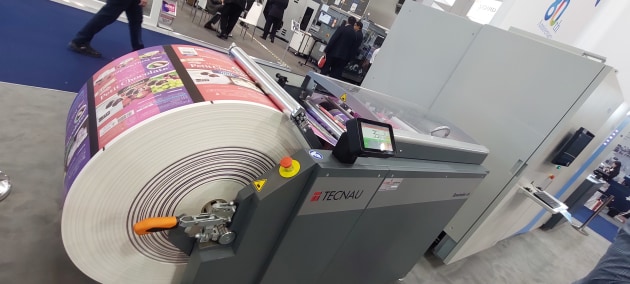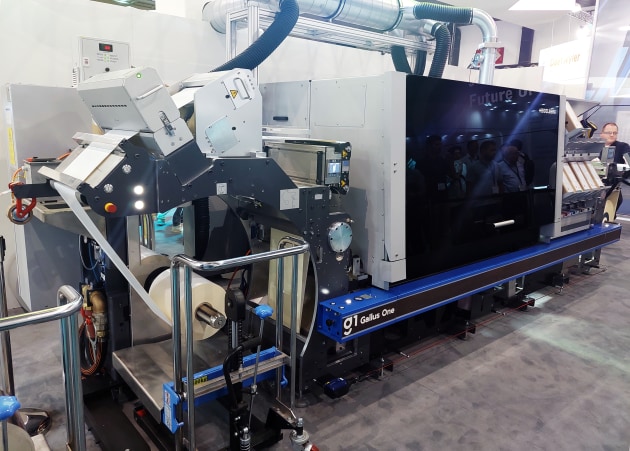Labelexpo, the global label printing show, has just had its last outing in Brussels before a move to Barcelona in 2025. PKN associate editor Wayne Robinson was there, and analyses the major trends emerging during the four day expo.
Labelexpo 2023 was the biggest show in the 40-year history of the world’s premier label exhibition. There were 600 exhibitors filling what must be one of the world’s finest Art Deco building complex, the impressive Parc Des Expositions in Brussels.
Visitors, which included a sizeable number of printers from Australia and New Zealand, were at a show that was rich in technology, opportunity and education, all aimed to help drive their businesses forward.
Thanks to digital printing technology, labels is now a field that is open to printers of all sizes, including dedicated label print shops of course, but also everyone else from franchises and copy shops, up to major commercial print groups, flexible and folding carton packaging companies, and entrepreneurs looking for a growing market.
Label print businesses and commercial printers in labels have had a good few years, with Covid providing a boom in labelling, and all forecasts are that the labels market will continue to grow.

Labelexpo had a plethora of traditional, digital and hybrid label printing presses, converting equipment and embellishing systems at the centre of an exhibition that showed every possible way to create labels and add value to them.
Along with demonstrations of the latest printing and converting equipment at the show, there were various masterclasses, and special events focused on automation and flexible packaging.
The key themes that emerged during the event were clear to see: the drive to achieve sustainability; the rise of digital printing; the broadening of applications for label printers; and the imperative for integrated production processes to optimise efficiencies.
Sustainability was the over-arching trend. Legislators and brands are demanding labels join the circular economy, which essentially means diverting packaging from landfill and towards recovery and clean separation of materials, which then become feedstock for new labels and packaging products. There are two main lines of development, one is the introduction of new bio-mass materials in the manufacturing of labelstock, the other is in PCR (post consumer recovery) – the incorporation of used labels in the manufacture of new labels.
The major labelstock suppliers are at the forefront of sustainability developments. On the UPM Raflatac stand for instance, the company was showing its newly introduced Ocean Action Labels, made from ocean-bound plastic waste. It also had the PureCycle paper wash-off labels that cleanly separate from primary packaging in PET and HDPE recycling streams.
Linerless was a major sustainability focus with another major player in labels, Avery Dennison, showing its new ADLinrSave linerless system, targeted at the prime label market. It has had linerless for functional labels for some time, but the two new linerless prime label products demonstrate its intent to bring the technology to all.
As well as a move to sustainable self-adhesive labels there are moves in shrink sleeves, a trickier proposition as you need to separate the PET container material and PET shrink sleeves, but development is underway.
Sustainability in labels, though, is not just limited to the labelstock, virtually every stand at the show was highlighting environmental developments, whether in using less power to run equipment, less waste in makeready, or recyclable parts and consumables.
The largest stand at the show, that of HP Indigo, had sustainability as a key theme, and was evidence of the second major trend, that of the rise of digital printing. HP Indigo – represented in ANZ by Currie Group – is the world’s biggest supplier of digital label and packaging printing systems. Highlights of its stand were the new V12 120-metres-a-minute label press, and the new HP 200K digital flexibles packaging press.
HP says the V12 will replace two or three older analogue flexo presses, and is targeted at print businesses typically running jobs between two and seven kilometres, which represents a whole new ball game for digital print systems.
While much of the emphasis here is on digital technology, the analogue flexo press manufacturers were out in force, including OMET, the Italian company, which celebrated its sixtieth anniversary with a nightly party on its stand.

Kflex is a modular platform press handling substrates from 12 microns up to aluminum lidding and light cartonboard. Targeted at end-use applications in the wine and spirits, food and beverage, household, industrial, healthcare and cosmetics markets, the press is designed to handle everything from self-adhesive labels to wet glue, multi-layer, wraparound and shrink sleeve labels, to lids.
Flexo label press manufacturers Mark Andy, represented in ANZ by Aldus Group, along with other major brands such as Nilpeter, Edale, Bobst and Gallus were all out in force, and all them had pure flexo presses, and hybrid machines, with some, Gallus for instance, launching new digital presses, in its case the entry level GallusOne.
Mark Andy had a new, entry-level, flexo press on the stand and two digital label presses. Nilpeter went for two flexo presses. For medium to long run labels, which will remain a large part of the market, flexo printing offers real cost benefits over digital.
Although this is primarily a label show, packaging is now a major theme, specifically short run, value-added flexible packaging, which offers label converters an opportunity to diversify their product offering and provide brands with a ‘one-stop shop’ for printed packaging.
Label converters can use the same expertise they already bring to label conversion – short turnaround, fast job changeover, in-line and near-line decoration – to bring flexible packaging buyers shorter ordering times, lower minimum quantities, multiple variants and personalisation or mass customisation.

At Labelexpo, the Flex Pack Trail gave label converters all the information they need to enter this market: what they need to know about digital and conventional press technologies; flexpack material constructions; coating, laminating, ink and curing requirements; in-line and near-line decoration options; QC and migration testing.
Visitors were also able to deepen their technical knowledge of flexible packaging at an expert-led masterclass, organised by the Label Academy, covering topics such as substrates; creation of artwork and pre-press; printing processes and techniques; inks, coatings, curing and laminating; and converting flexible packaging.
In a world where label printers are facing increased competition from commercial printers getting into labels, it seems appropriate that they should be looking at broadening their market opportunities through leveraging their existing skill sets with new technology – this show certainly helped them to see that is possible. Of course, flexible packaging and folding carton is quite different to labels, but now entirely possible for label printers to produce.
The final unmissable trend that print people saw as they ventured onto the stands to talk to the vendors is the move to integrate production equipment – label presses, converting and embellishing kit – into an integrated workflow.
Manufacturers are increasingly recognising that actual printing is but one part of the whole manufacturing process, which starts at the estimate and ends at the invoice, and that to gain the maximum efficiencies from the machine, and from the business, an end-to-end ecosystem is the way to go.
By using digital data to drive manufacturing, provide management analysis, and to deliver real time connection through the cloud to vendor service, benchmarking and consumables supply, label print businesses can turbo-charge their productivity and efficiency.
Developers such as eProductivity Software are producing systems that act as the nerve centre of a label printing business, connecting everything, and enabling label print business owners to achieve the efficiencies that the digital online world enables.
So, as the world’s label printing fraternity returned to their businesses to digest all the themes from the show, it was au revoir to Brussels and ola to Barcelona. Labelexpo 2023 will be remembered for the major strides the industry is taking to exploit the power of digitalisation, and on its journey to sustainability.
This article was first published in PKN Packaging News November-December 2023 print issue, page 32.






